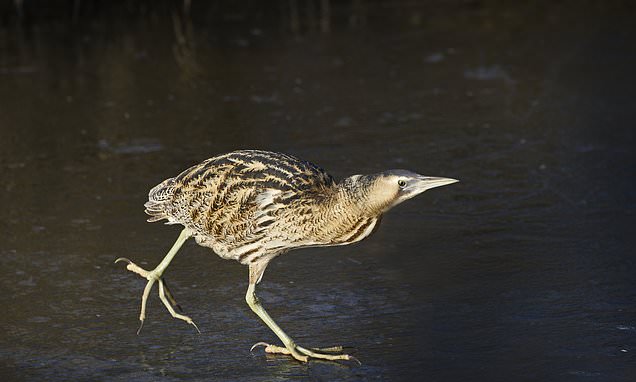Incredibly shy bitterns are making a comeback in the UK after the bird nearly died out
- The brown heron-like creatures were on the brink of dying out in the UK in 1997
- They can be tracked by booming noise they emit when trying to attract a mate
- This year, the RSPB recorded 198 males at 89 sites, compared to 188 last year
Birdwatchers are revelling at the chance of glimpsing the famously timid bittern as the species makes a comeback to the UK’s wetlands.
The brown heron-like creatures which skulk among the reeds were on the brink of dying out in 1997 when the entire national population dwindled to just 11.
But an astonishing revival has catapulted this year’s breeding to its most rapid rate since records began.
Scroll down for video
The brown heron-like creatures which skulk among the reeds were on the brink of dying out in 1997 when the entire national population dwindled to just 11. But an astonishing revival has catapulted this year’s breeding to its most rapid rate since records began (file photo)
Although the painfully shy creatures are tough to spot, bitterns can be tracked by the strange booming noise they emit when trying to attract a mate.
The sound can be heard from two miles away and allows naturalists to count the birds.
Hunted and persecuted, bitterns had completely disappeared in Britain by the 1870s, before re-colonising early in the 20th century.
After a worrying drop at the turn of this century, new habitats were created and since 2006, there has been a year-on-year increase.
This year, the RSPB recorded 198 males at 89 sites, compared to 188 at 82 sites in 2018.
Booming was reported from five new locations across the country and, although the number of confirmed booming males in Somerset dropped from 55 to 48, record levels were noted in the Fens and northeast England.
Simon Wotton, RSPB senior conservation scientist, said ‘Bitterns are one our most charismatic birds.
‘Their astonishing recovery from the brink of extinction is a real conservation success story and example of what is possible through targeted efforts to restore wildlife habitat.
Although the painfully shy creatures are tough to spot, bitterns can be tracked by the strange booming noise they emit when trying to attract a mate. The sound can be heard from two miles away and allows naturalists to count the birds (file photo)
WHAT ARE BITTERNS?
The bittern is a thickset heron with all-over bright, pale, buffy-brown plumage covered with dark streaks and bars.
It flies on broad, rounded, bowed wings.
A secretive bird, very difficult to see, as it moves silently through reeds at water’s edge, looking for fish.
The males make a remarkable far-carrying, booming sound in spring.
It’s very small, reedbed-dependent population make it an Amber List species.
They eat fish, amphibians and insects.
Bitterns can be found around wetlands with large reedbeds, especially RSPB reserves at Minsmere, Suffolk, and Leighton Moss, Lancashire.
Source: RSPB
‘It’s a delight to hear their distinctive booming call echoing across the reedbeds every year as more and more bitterns are making new or restored wetlands their home.’
Two EU LIFE-funded projects helped reinvigorate the bittern population, alongside the legal safeguards in place within Special Protection Areas (SPAs)
However, the number of SPAs has not increased for 20 years, despite plans to designate more SPAs as bitterns arrived in their newly created habitats.
When the RSPB first started regular annual bittern monitoring in 1990, over 90 per cent of booming males were found on SPAs designated for the bird, but this year that figure stood at only 23 per cent.
This potentially leaves bittern nests vulnerable to damage and destruction.
The UK has the second-lowest proportion of its national territory designated as SPAs among the EU’s 28 member states.
The RSPB’s conservation director, Martin Harper, said ‘The recovery of bittern is a great success story. It highlights the importance of nature reserves and protected areas in providing this species a lifeline.
‘Equally, we know that dedicated funding from the EU has been instrumental in driving positive action.
‘Rhetorical commitments to restore nature in a generation must be backed up with legal targets and adequate resources.
‘That is why it is essential that governments across the UK pass new environment laws to drive nature’s recovery and replace the funding that will be lost if and when the UK leaves the European Union.’
Source: Read Full Article


